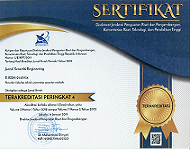Evaluasi Sifat Mekanik Lentur Beton Menggunakan Serat Abaka dan Substitusi Abu Cangkang Tiram
Keywords:
Abu Cangkang Tiram, Kuat Lentur, Limbah, Serat Abaka, BetonAbstract
Flexural strength is one of the mechanical properties of concrete that is often overlooked in achieving maximum concrete performance. Abaca fiber, a natural fiber, has been widely used to enhance the flexural strength of concrete. However, its utilization remains limited and has never been combined with Oyster Shell Ash (OSA). Therefore, this study aims to determine the density, slump flow, and flexural strength of high-strength concrete with a 5% substitution of OSA, supplemented with 2% superplasticizer and abaca fiber at proportions of 0.15%, 0.30%, and 0.45%, with curing for 28 days. The oyster shells were sourced from Surien, Meuraxa District, Banda Aceh City, while the abaca fibers were obtained from East Java. The experimental design followed the ACI 211.4R-93 (American Concrete Institute) method. The results showed that an excessive addition of abaca fiber reduces the density of concrete. Incorporating 0.15% abaca fiber increases the flexural strength of concrete. The combination of 5% OSA substitution with abaca fiber further improves flexural strength.
References
[1] Y. F. Z. Dewi, H. Manalip, and R. S. Windah, “Pengaruh Penggunaan Serbuk Cangkang Telur Sebagai Substitusi Parsial Semen Terhadap Nilai Kuat Tarik Belah Beton,” J. Sipil Statik, vol. 8, no. 3, 2020.
[2] Nugraha, Paul. "Teknologi Beton Dari Material, Pembuatan, Ke Beton Kinerja Tinggi, LPPM Univ." Kristen Petra, Surabaya (2007).
[3] P. Hunton, “Research on eggshell structure and quality: an historical overview,” Brazilian J. Poult. Sci., vol. 7, pp. 67–71, 2005.
[4] F. D. Rahmayanti, “Pemanfaatan Limbah Cangkang Telur Sebagai Pupuk Makro (Ca) Pada Tanaman Bawang Merah,” AGRISIA-Jurnal Ilmu-Ilmu Pertan., vol. 12, no. 2, 2020.
[5] F. Handayani Syahputra, “Isolasi dan karakterisasi nanokalsium dari cangkang tiram (Crassostrea gigas),” Jphpi, vol. 20, no. 3, pp. 515–523, 2017.
[6] V. Vilela Rocha, P. Ludvig, A. C. Constancio Trindade, and F. de Andrade Silva, “The influence of carbon nanotubes on the fracture energy, flexural and tensile behavior of cement based composites,” Constr. Build. Mater., vol. 209, pp. 1–8, 2019, doi: 10.1016/j.conbuildmat.2019.03.003.
[7] Y. Li, W. D. Song, and P. Z. Hong, “Changing wastes into valuables-discussion on comprehensive development and utilization of oyster shell,” in Doctor. Expert Forum, 2007, p. 26.
[8] Q. Song, Q. Wang, S. Xu, J. Mao, X. Li, and Y. Zhao, “Properties of water-repellent concrete mortar containing superhydrophobic oyster shell powder,” Constr. Build. Mater., vol. 337, p. 127423, 2022.
[9] O. A. Ubachukwu and F. O. Okafor, “Investigation of the Supplementary Cementitious Potentials of Oyster Shell Powder for Eco-Friendly and Low-cost Concrete,” Electron. J. Geotech. Eng., vol. 24, no. 5, pp. 1297–1306, 2019.
[10] Erfanto, Anggi, Roski RI Legrans, and Alva N. Sarajar. "Pengaruh Penambahan Geopolymer Berbahan Fly Ash Dari PLTU Terhadap Kuat Geser Pada Tanah Pasir Berlempung." TEKNO 18.76 (2020).
[11] R. Anthony, S. Y. Awasthi, P. Singh, and V. R. P. Kumar, “An experimental and characteristic study of abaca fiber concrete,” in IOP Conference Series: Materials Science and Engineering, 2020, vol. 912, no. 3, p. 32077.
[12] B. Bunyamin, “Pengaruh Sambungan Beton Pracetak Hollow Block terhadap Pola Retak yang Timbul,” J. Serambi Eng., vol. 5, no. 2, 2020.
[13] N. Permatasari, B. Bunyamin, M. Hady, D. A. Hafiz, N. Lathifah, and M. H. Auliyah, “Utilization of Rice Field Conch Shells as a partial substitution of Cement and Fine Aggregate for Split Tensile Strength of Concrete,” in E3S Web of Conferences, 2024, vol. 476, p. 1018.
[14] B. Bunyamin, M. Hady, N. Hendrifa, and A. Syakir, “Analisis Kuat Tekan Beton Menggunakan Bahan Substitusi Serat Roving dan Cangkang Tiram,” J. Serambi Eng., vol. 8, no. 3, 2023.
[15] M. Hady, B. Bunyamin, D. Darwin, A. Rahman, and A. Satria, “Pemanfaatan Cangkang Keong Sawah Sebagai Substitusi Sebahagian Semen Dan Agregat Halus Terhadap Kuat Tekan Beton,” J. Tek. Sipil dan Teknol. Konstr., vol. 8, no. 1, 2022.
[16] B. Bunyamin and A. Mukhlis, “Utilization of Oyster Shells as a Substitute Part of Cement and Fine Aggregate in the Compressive Strength of Concrete,” Aceh Int. J. Sci. Technol., vol. 9, no. 3, 2020.
[17] F. D. Pratama, B. Bunyamin, and F. D. Kurniasari, “Pengaruh Penggunaan Subtitusi Filler Serbuk Kayu Pada Campuran Lapisan Aspal Beton,” J. Tek. Sipil Unaya, vol. 7, no. 2, pp. 123–134, 2021.
[18] B. Bunyamin, R. P. Munirwan, M. Ridha, and N. Hendrifa, “Utilization of wood processing dust as a substitute for a part of cement in concrete,” in IOP Conference Series: Materials Science and Engineering, 2021, vol. 1087, no. 1, p. 12004.
[19] B. Bunyamin, M. Hady, R. P. Munirwan, R. Putra Jaya, and others, “Cymbopogon nardus Leaf Ash as an Alternative Material for Enhancing Concrete Strength,” Adv. Civ. Eng., vol. 2024, 2024.
[20] B. Bunyamin, F. D. Kurniasari, R. P. Munirwan, and R. Putra Jaya, “Effect of Coral Aggregates of Blended Cement Concrete Subjected to Different Water Immersion Condition,” Adv. Civ. Eng., vol. 2022, 2022.
[21] C. ASTM, “29/C 29M-97,” Stand. Test Method Bulk Density (“Unit Weight. Voids Aggreg., 2010.
[22] A. ASTM C127, “Standard test method for specific gravity and absorption of coarse aggregate,” Am. Soc. Test. Mater., 1993.
[23] A. International, “ASTM C136-01, Standard Test Method for Sieve Analysis of Fine and Coarse Aggregates,” ASTM Int. West Conshohocken, PA, 2001.
[24] Bunyamin, “Comparison of deflection of hollow block concrete blocks with normal reinforced concrete beam,” in AIP Conference Proceedings, 2019, vol. 2059, no. 1, p. 20039.
[25] B. Bunyamin, N. Hendrifa, and M. Ridha, “Pengaruh Substitusi Cangkang Tiram Sebagai Pengganti Sebahagian Semen Dan Pasir Halus Terhadap Kuat Tarik Belah Beton,” TERAS J., vol. 11, no. 2, pp. 272–281, 2021.
[26] ASTMC39/C39M-20, “Standard test method for compressive strength of cylindrical concrete specimens,” 2012.
[27] M. Hasan, T. Saidi, M. Jamil, Z. Amalia, and A. Mubarak, “Mechanical Properties and Absorption of High-Strength Fiber-Reinforced Concrete (HSFRC) with Sustainable Natural Fibers,” Buildings, vol. 12, no. 12, p. 2262, 2022.
[28] N. Nurfatirah, H. Zainab, H. Othman, H. K. Farizul, and A. Rozaini, “Effect of Temperature in Calcination Process of Seashells,” Malaysian J. Anal. Sci., vol. 19, no. 1, pp. 65–70, 2015.
[29] R. Tampi, H. Parung, R. Djamaluddin, and A. A. Amiruddin, “Reinforced concrete mixture using abaca fiber,” in IOP Conference Series: Earth and Environmental Science, 2020, vol. 419, no. 1, p. 12060.
[30] Y. Han, R. Lin, and X.-Y. Wang, “Sustainable mixtures using waste oyster shell powder and slag instead of cement: Performance and multi-objective optimization design,” Constr. Build. Mater., vol. 348, p. 128642, 2022.
[31] G. O. Manlapas, L. E. Cardenas, and E. T. Anacta, “Utilization of bamboo fiber as a component material in concrete,” Indian J Sci Technol, vol. 11, pp. 1–9, 2017.
[32] M. Ardanuy, J. Claramunt, and R. D. Toledo Filho, “Cellulosic fiber reinforced cement-based composites: A review of recent research,” Constr. Build. Mater., vol. 79, pp. 115–128, 2015.
[33] O. Faruk, A. K. Bledzki, H.-P. Fink, and M. Sain, “Biocomposites reinforced with natural fibers: 2000--2010,” Prog. Polym. Sci., vol. 37, no. 11, pp. 1552–1596, 2012.
[34] E. C. Arvaniti et al., “Determination of particle size, surface area, and shape of supplementary cementitious materials by different techniques,” Mater. Struct., vol. 48, pp. 3687–3701, 2015.
[35] A. Elbehiry, O. Elnawawy, M. Kassem, A. Zaher, N. Uddin, and M. Mostafa, “Performance of concrete beams reinforced using banana fiber bars,” Case Stud. Constr. Mater., vol. 13, p. e00361, 2020.
Downloads
Published
Issue
Section
License
Copyright (c) 2025 Muhammad Iqbal, Bunyamin , Heru Pramanda, Rafiqa Muhnita Yusputri (Author)

This work is licensed under a Creative Commons Attribution 4.0 International License.












